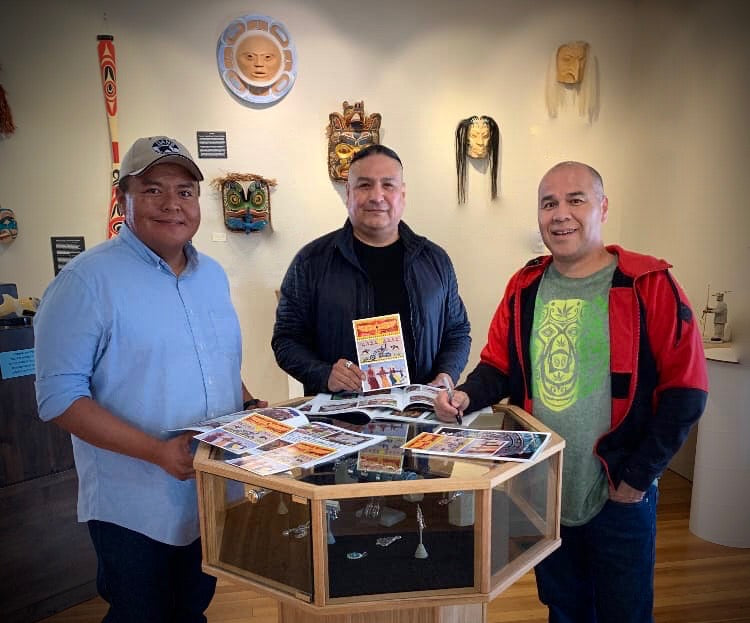Honoring the Past, Exploring New Possibilities

Traditional and Contemporary:
Native American Fine Art Event
The ‘modern’ appearance of many Native American artists’ paintings can construe incorrect perceptions about its ‘Native-ness.’ Paintings that are oil-on-canvas, for instance, give the impression of a European genre. Yet, paintings have a distinct artistic lineage for North American Tribes.
The First Peoples of North America painted on rock walls for millenniums, leaving behind tens of thousands of still existing pictographs. At some point, early Native Americans also began painting on animals skins, sometimes using these as an annual ‘winter count’ to mark the passing of years. After Westerners conquered these lands, killed off the buffalo, and sent the People onto reservations or the warriors to prisons, the materials necessary for the skin paintings disappeared.
Reservation Indian Agents of the Great Plains or the officials at prisons began giving these former painters and indigenous historians used pages from their ledger books, along with fountain pens, crayons, or watercolor paints. The works produced during this period are known as ‘ledger art,’ and it continued into the 1910’s.
In the 1920’s a group of Southern Plains Indians in Oklahoma, The Kiowa Five, began an art movement with contemporary art supplies. They initially based their style of work on the ledger art genre, and it came to be known as The Plains Style. Further, the Studio School opened within the Santa Fe Indian School in 1932 and also developed its take on the ledger art approach; this branch is now referred to as the Santa Fe Style of Native American painting.
The genre of Native American painting continued down other paths to include commonly using oils on canvas by the 1960’s. Today, a number of modernist techniques are now utilized including Pop Art. Thus, while oil-on-canvas works per se are not a traditional American Indian art form, paintings most certainly are.
The two dimensional works of artists Terrance Guardipee, Blackfeet, Jason Parrish, Navajo, and Roger Perkins Mohawk, span our concepts of what traditional and contemporary Native American art looks like. Their works can also begin the challenging dilemma of articulating why a work should be considered with either of these two authoritative terms.
Typically, ‘traditional’ is thought of as works based upon time-honored, older perspectives along with current works that respect the heritage and legacy, which guided earlier artists. In that case, Jason’s and many of Terrance’s works must be seen as traditional.
Jason paints in the Santa Fe School tradition. A certain ‘less is more’ conceptual approach may describe Jason’s desert scenes of the Navajo in elegant poses or in motion on horseback.
Jason’s recent second showing at the juried International Watercolor Exhibition, held in the Grand Palais on the Champs Elysees of Paris, demonstrates growing international recognition for his works. His piece, Antelope Hunt, just received a National Award that will be announced by the presenting organization on June 15.
Terrance works in the Ledger Art genre. He not only paints upon antique ledger pages, he was the artist most instrumental in reviving this narrative art form in the 1990’s. His works can be found in numerous museums throughout the United States, including the Smithsonian.
‘Contemporary’ is thought of as works that allow an artist to explore new possibilities, to offer what might be, thus possibly adding to a culture. In that case, Roger and many of Terrance’s works must be regarded as contemporary.
Roger’s favored medium is Pop Art. His pieces make bold statements about the Native American world. In one work, the iconic black and white photo of Sitting Bull looking straight at you with pride, defiance, and a withering gaze has the great chief’s head encircled by a pink halo. Roger also depicts him wearing dark sunglasses, perhaps disallowing a direct look into the eyes of the warrior—holy man—chieftain.
Roger gives the following reason for working in the pop art style, “For years, we’ve had these iconic monochrome photos staring out at us, reminding us of what we were and won’t ever be again. That can get depressing. We have a now! We have a future! It needs to be colorful, energetic, humorous, and positive. That’s what I’m showing in my works.”
Terrance gathers antique paper items—a ledger page, bank note, map, photo—to create collages of past times. This ephemera provides a complex backdrop to the powerful Blackfeet imagery that he then draws upon it. Additionally, his vibrant acrylic paintings push into modernist styles, ranging from Fauvism to Expressionism to Pop Art.
This methodology of looking at artwork—traditional or contemporary—comes about because of a sequence we intuitively undertake without realizing it. It goes—first identify, then analyze. That’s followed by define, characterize, and classify. We know this as ‘organization.’ When considering similar things over a long period of time, we further organize into periods or eras. However, it’s a slippery slope.
These very topics—traditional and contemporary; stasis, transition, evolution—will be discussed Saturday afternoon in a panel/ open forum conversation. Please join these artists for insightful considerations about Native American art—then, now, and tomorrow.
The artists will be having their show in Sisters June 21 – 23. Friday: Artist Reception from 5 to 8 pm with non-alcoholic refreshments/ finger food. Saturday: Artists available 11 – 5 pm, with the panel discussion beginning at 1:30. Sunday: artists available 11:00 am till mid-afternoon. All events will take place at Raven Makes Gallery, 182 E. Hood Ave.